
Northampton Guildhall is a municipal building in St Giles' Square in Northampton, England. It is a Grade II* listed building.

Leicester Town Hall stands at Town Hall Square in the city centre of Leicester, England. The building, which is the meeting place of Leicester City Council, is a Grade II* listed building.

Crewe War Memorial stands in the Municipal Square, in Crewe, Cheshire, England. It consists of a bronze sculpture of Britannia standing on a pedestal, itself on a square base. The sculptor was Walter Gilbert and the sculpture was cast in the foundry of H. H. Martin and Company. It was unveiled in 1924. The names of those killed in both world wars and in later conflicts are inscribed on bronze plaques around the base, and there are further inscriptions on the paving around the memorial. It originally stood in Market Square and was moved to Municipal Square in 2006. The memorial is recorded in the National Heritage List for England as a designated Grade II listed building.

Cheltenham Borough Council is the local authority for Cheltenham, a non-metropolitan district with borough status in Gloucestershire, England. The council is based at the Municipal Offices on the Promenade.

Streatham War Memorial is a war memorial to the war dead of the London district of Streatham in the two World Wars. It was unveiled in 1922, and is sited near the northwest corner of Streatham Common, London Borough of Lambeth, England.
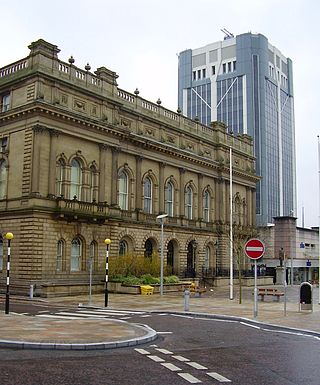
Blackburn Town Hall is a municipal building in King William Street, Blackburn, England. The town hall, which is the headquarters of Blackburn with Darwen Borough Council, is a Grade II listed building.

Bury Town Hall is a municipal building in Knowsley Street, Bury, Greater Manchester, England. The town hall, which is the headquarters of Metropolitan Borough of Bury, is a locally listed building.
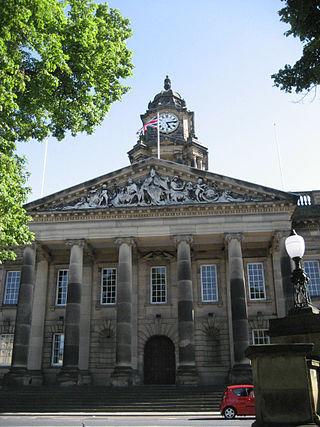
Lancaster Town Hall is a municipal building in Dalton Square, Lancaster, Lancashire, England. It was built in 1909 and is a Grade II* listed building.

Bournemouth Town Hall is a municipal facility in Bourne Road, Bournemouth, England. The town hall, which is the meeting place of Bournemouth, Christchurch and Poole Council, is a Grade II listed building. The town hall stands opposite Bournemouth Gardens and the Bournemouth War Memorial and is adjacent to St. Andrew's Church, Richmond Hill.
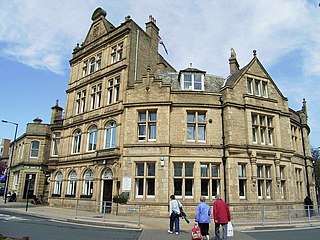
Keighley Town Hall is an early 20th century municipal building in Keighley, West Yorkshire, England. It is a Grade II listed building.

Brighouse Town Hall is a former municipal building in Thornton Square, Brighouse, West Yorkshire, England. The town hall, which was the headquarters of Brighouse Borough Council, is a Grade II listed building.

Aldershot Town Hall is a municipal building in Grosvenor Road, Aldershot, Hampshire, England. The town hall, which was the headquarters of Aldershot Borough Council, is a Grade II listed building.
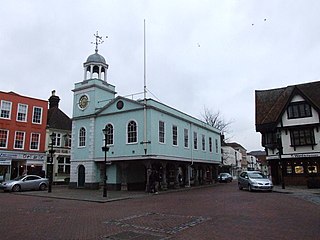
Faversham Guildhall is a municipal building in the Market Place in Faversham, Kent, England. The structure, which was the meeting place of Faversham Borough Council, is a Grade II* listed building.

Carmarthen Guildhall is a municipal structure in Guildhall Square, Carmarthen, Wales. The guildhall, which was the headquarters of Carmarthen Borough Council, is a Grade I listed building.

Horbury Town Hall is a former municipal building in Westfield Road, Horbury, West Yorkshire, England. The structure, which is now used as business centre, is a locally listed building.

The Town House is a municipal building in Union Street in Yeovil, Somerset, England. The building, which is the meeting place of Yeovil Town Council, is a Grade II listed building.

Hanley Town Hall is a municipal building in Albion Square in Hanley, Staffordshire, England. The building, which is used as the local register office, is a Grade II listed building.
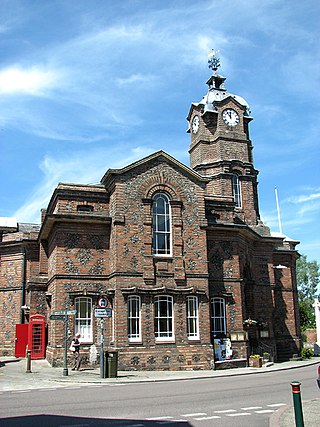
Eye Town Hall is a municipal building in Broad Street in Eye, Suffolk, England. The building, which is the meeting place of Eye Town Council, is a Grade II* listed building.

The Old Town Hall is a municipal building in Old Market Street, Usk, Monmouthshire, Wales. The structure, which is now used as the local club of the Royal British Legion, is a Grade II listed building.

The Council Offices, also known as the Welwyn Hatfield Borough Council Offices, is a municipal building on The Campus in Welwyn Garden City, Hertfordshire, England. The structure accommodates the offices and meeting place of Welwyn Hatfield Borough Council.





















